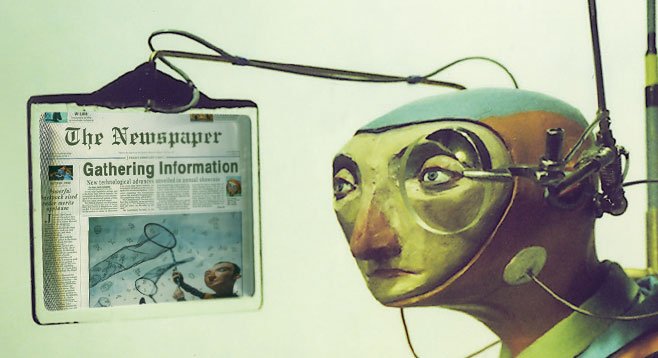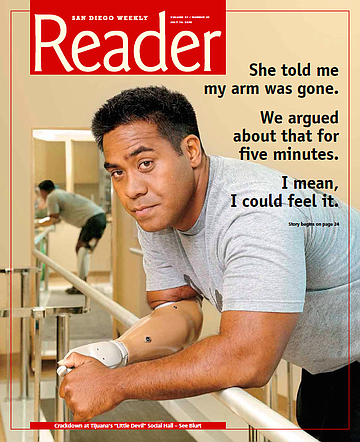 Facebook
Facebook
 X
X
 Instagram
Instagram
 TikTok
TikTok
 Youtube
Youtube


Like many hackers, David Nakamura Hulton goes by more than one name. His other one, his handle, is h1kari. Some people say you shouldn’t ask a hacker what his handle means. Handles aren’t always meant to be serious. Sometimes they’re designed to foil any journalist who assumes a handle is a window into a hacker’s soul. At the least, your inquiry indicates you’re a rube in hacker circles. But when Hulton greets me at the far end of the Starlight Ballroom one Friday evening in September, he offers both names, along with a handshake, and, unprompted, says of his handle’s homonym, hikari, “It’s a Japanese word. It means ‘divine light’ or ‘enlightenment.’
By Jeanne Schinto, June 19, 2003 | Read full article

UCSD — Atop one of the last open bluffs in La Jolla, on the campus of UCSD, a tattered homemade swing hangs from a giant old eucalyptus tree. Swept by Pacific breezes, the land commands a sweeping view of the La Jolla coast and the ocean beyond.
The property has been a place of rare solitude on the busy university campus. Many locals think it should stay that way, a place to sit alone and reflect on the beauty of nature and the peaceful sea beyond. Others say that if the land is to be developed at all, it should be as labs and classrooms for students and graduate researchers.
But this site, one of the few remaining tracts of undeveloped ocean-view property owned by the university, is coveted by J. Craig Venter, known as the nation’s preeminent gene warrior, a skilled street fighter in the halls of academe and government, and one of the most controversial figures in the history of modern science.
By Matt Potter, Nov. 25, 2008 | Read full article

When I was in school, I was given two pieces of information about the brain that, well, stuck in my brain. The first was that the brain was hardwired, meaning that each bit of the brain had a specific function and if that bit were damaged then that particular function was lost forever. The second piece of information was that even though the brain consisted of billions of nerve cells called neurons, I was constantly losing them and I would never get them back.
As a kid, it seemed I was so rich in neurons that the loss caused by a few six-packs during the week or a rough pickup football game without a helmet meant nothing. After all, I was a billionaire.
By Stephen Dobyns, July 9, 2008 | Read full article

Cárdenas is spending more than 15 consecutive days living in Second Life. “My contract with myself was to be in Second Life for 365 hours [wearing the headset], except when I go to the bathroom.”
In addition to the headset, Cárdenas wears motion-capture hardware on his body. Eight cameras mounted high on the walls around the 15-by-30–foot room capture his motion and translate it to the brightly colored dragon on the movie screen at one end of the room. The cameras, from my seat on the couch, which sits dead center in the room, look like big red eyes peering down at me. On-screen, the dragon stands in the middle of a Second Life room that has been constructed to look like the room we’re in.
By Ernie Grimm, March 25, 2009 | Read full article

I was introduced to this technological tinkering and amateur tech research by my friend, Al. Last year, he and a small group of others developed a game in which the player slaps one of several tiny pods when the pods randomly light up. Think of it as a cross between Whac-A-Mole and the old memory game Simon: you set the little pods in front of you, they light up, play an electronic note, then you try to whack ’em with your palm. There’s a scoreboard, and the whole thing looks like it was created to captivate the attention of children living in the movie world of The Fifth Element. This game made by regular (but pretty smart) folks.
By Ollie , March 9, 2011 | Read full article

On the Fourth of July this summer, a free app appeared in Google Play Store to help Americans make neighborhoods safer from the misuse of guns. Brett Stalbaum, who is 46 and has been a lecturer in the visual arts department at the University of California San Diego for 11 years, created the app in the university’s Walkingtools.net Laboratory for exclusive use on Android phones.
Gun Geo Marker used global positioning technology to allow people to tag the location of dangerous guns and people suggested of dangerous gun practices in their neighborhoods.
By Joe Deegan, Nov. 13, 2013 | Read full article



Like many hackers, David Nakamura Hulton goes by more than one name. His other one, his handle, is h1kari. Some people say you shouldn’t ask a hacker what his handle means. Handles aren’t always meant to be serious. Sometimes they’re designed to foil any journalist who assumes a handle is a window into a hacker’s soul. At the least, your inquiry indicates you’re a rube in hacker circles. But when Hulton greets me at the far end of the Starlight Ballroom one Friday evening in September, he offers both names, along with a handshake, and, unprompted, says of his handle’s homonym, hikari, “It’s a Japanese word. It means ‘divine light’ or ‘enlightenment.’
By Jeanne Schinto, June 19, 2003 | Read full article

UCSD — Atop one of the last open bluffs in La Jolla, on the campus of UCSD, a tattered homemade swing hangs from a giant old eucalyptus tree. Swept by Pacific breezes, the land commands a sweeping view of the La Jolla coast and the ocean beyond.
The property has been a place of rare solitude on the busy university campus. Many locals think it should stay that way, a place to sit alone and reflect on the beauty of nature and the peaceful sea beyond. Others say that if the land is to be developed at all, it should be as labs and classrooms for students and graduate researchers.
But this site, one of the few remaining tracts of undeveloped ocean-view property owned by the university, is coveted by J. Craig Venter, known as the nation’s preeminent gene warrior, a skilled street fighter in the halls of academe and government, and one of the most controversial figures in the history of modern science.
By Matt Potter, Nov. 25, 2008 | Read full article

When I was in school, I was given two pieces of information about the brain that, well, stuck in my brain. The first was that the brain was hardwired, meaning that each bit of the brain had a specific function and if that bit were damaged then that particular function was lost forever. The second piece of information was that even though the brain consisted of billions of nerve cells called neurons, I was constantly losing them and I would never get them back.
As a kid, it seemed I was so rich in neurons that the loss caused by a few six-packs during the week or a rough pickup football game without a helmet meant nothing. After all, I was a billionaire.
By Stephen Dobyns, July 9, 2008 | Read full article

Cárdenas is spending more than 15 consecutive days living in Second Life. “My contract with myself was to be in Second Life for 365 hours [wearing the headset], except when I go to the bathroom.”
In addition to the headset, Cárdenas wears motion-capture hardware on his body. Eight cameras mounted high on the walls around the 15-by-30–foot room capture his motion and translate it to the brightly colored dragon on the movie screen at one end of the room. The cameras, from my seat on the couch, which sits dead center in the room, look like big red eyes peering down at me. On-screen, the dragon stands in the middle of a Second Life room that has been constructed to look like the room we’re in.
By Ernie Grimm, March 25, 2009 | Read full article

I was introduced to this technological tinkering and amateur tech research by my friend, Al. Last year, he and a small group of others developed a game in which the player slaps one of several tiny pods when the pods randomly light up. Think of it as a cross between Whac-A-Mole and the old memory game Simon: you set the little pods in front of you, they light up, play an electronic note, then you try to whack ’em with your palm. There’s a scoreboard, and the whole thing looks like it was created to captivate the attention of children living in the movie world of The Fifth Element. This game made by regular (but pretty smart) folks.
By Ollie , March 9, 2011 | Read full article

On the Fourth of July this summer, a free app appeared in Google Play Store to help Americans make neighborhoods safer from the misuse of guns. Brett Stalbaum, who is 46 and has been a lecturer in the visual arts department at the University of California San Diego for 11 years, created the app in the university’s Walkingtools.net Laboratory for exclusive use on Android phones.
Gun Geo Marker used global positioning technology to allow people to tag the location of dangerous guns and people suggested of dangerous gun practices in their neighborhoods.
By Joe Deegan, Nov. 13, 2013 | Read full article
Comments